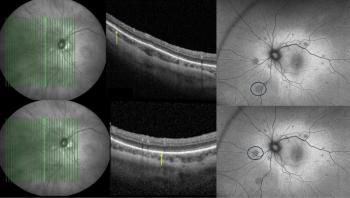
The ideal drop through the eyes of doctors and patients
Five steps and the criteria for success, as seen through the eyes of patients and their doctors...
Given the plethora of over-the-counter and prescription approaches available for dry eye, patient and clinician agreement on the appropriate regimen is key to treatment success. Coming to that agreement though can still be difficult.
Step 1 Communication
Invariably, the most important part of dry eye treatment is doctor-patient communication.
Further confounding patient-doctor agreement upon treatment is the conundrum occuring with a mismatch in clinical signs and subjective symptoms.
Although this situation does not occur too often, it certainly isn't uncommon and it is often due to a doctor missing a hint during an examination.
Step 2 Correct diagnosis
Research into clinician perceptions of the most important diagnostic characteristics shows them to be research evidence, ease of use and the time requirement, but careful assessment remains integral in capturing disease state.1
Examination of the eyelids is required to assess potential meibomian gland dysfunction and blepharitis, for example. Furthermore, lissamine green staining should be performed in conjunction with fluorescein staining to capture conjunctival staining in addition to keratitis.
Assessing tear break-up time also is important, because that too is a clue to the stability and quality of the patient's tear film. Beyond that, the Ocular Surface Disease Index or other patient symptoms surveys are also useful in assessing patient symptoms, especially in catching early stages of dry eye.
One of the major problems with the management of ocular surface disease is the lack of a standardized approach. Recommendations put forth in recent years demonstrate an attempt to standardize our approach to both diagnosing and monitoring ocular surface disease.2
Step 3 Finding the best treatment
As far as treatment is concerned, a good general rule is to be more aggressive in treating patients. This emphasizes to the patient that you are taking his or her ailment seriously.
In addition, compliance often is not good, so if you are suggesting more aggressive treatment and patients do not comply with everything you suggest, they are getting more treatment than they would if you suggested a less aggressive course.
Three primary situations exist that can lead to patient-physician disagreement regarding disease severity:
The doctor does not perceive the severity of the patient's problem and may assume that any artificial tear will solve the problems.
The patient does not perceive the severity of their situation, which can lead to poor compliance and requires comprehensive patient education.
The patient misattributes dry eye symptoms as another condition (e.g., attributes symptomatic blurred vision as visual acuity decrease rather than dry eye), which also suggests the need for patient education and dry eye treatment.
Step 4 Addressing treatment concerns
After identifying the patient's disease severity, it is important to assess patient concerns with treatment. Being empathetic and expressing a desire to hear their concerns and work with them to find a shared solution is vital to treatment success.
Research presented at the 2009 annual meeting of the Association for Research in Vision and Ophthalmology demonstrated that the primary clinician-rated goals in treating patients with moderate to severe dry-eye were maintenance and protection of the ocular surface. However, we certainly need to tend to patients' goals in treatment as well, because these are integrally tied to patient compliance.3
For patients who complain about visual blur or visual tasking difficulty, it may be best to recommend an ocular lubricant demonstrating visual function benefit.4
For patients with more severe disease that may not respond to ocular lubricant treatment alone, prescription cyclosporine 0.05% ophthalmic emulsion (Restasis, Allergan) may be added to the treatment regimen.
Newsletter
Get the essential updates shaping the future of pharma manufacturing and compliance—subscribe today to Pharmaceutical Technology and never miss a breakthrough.













































